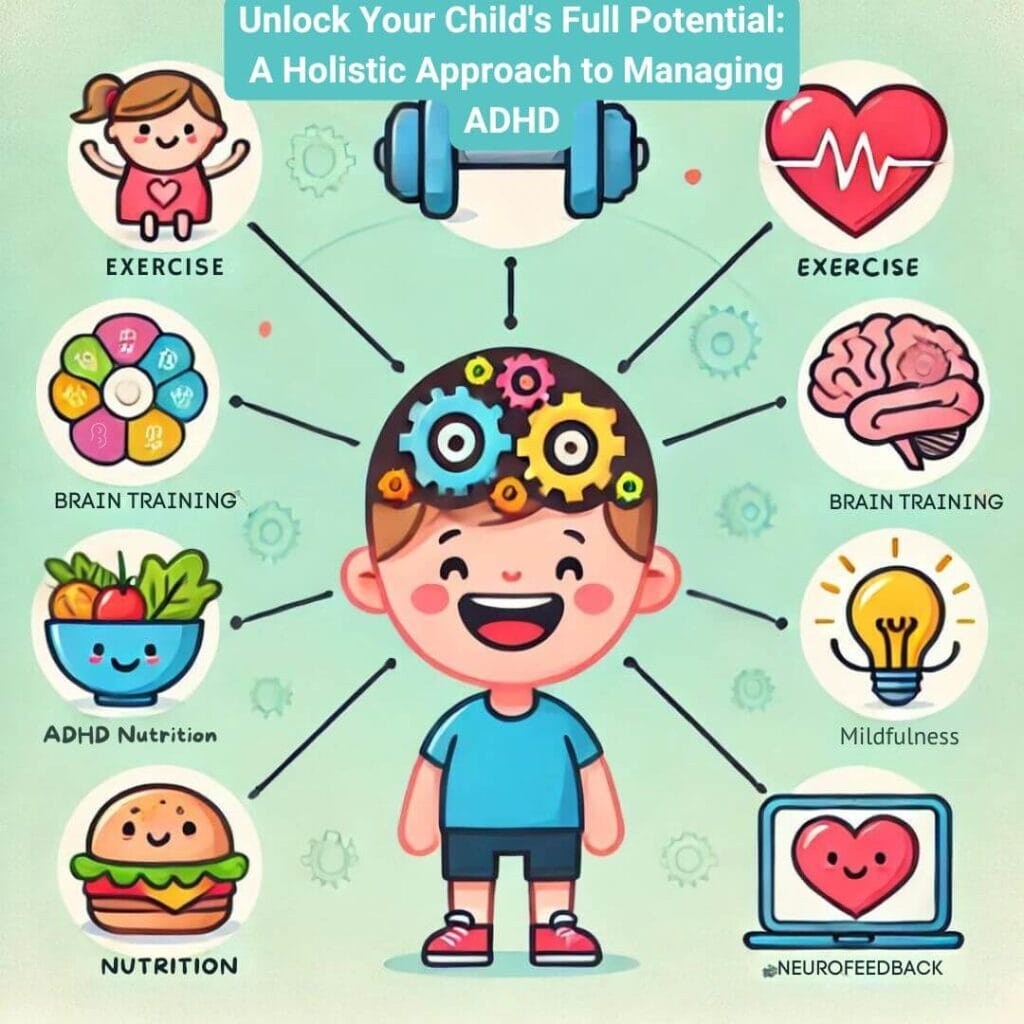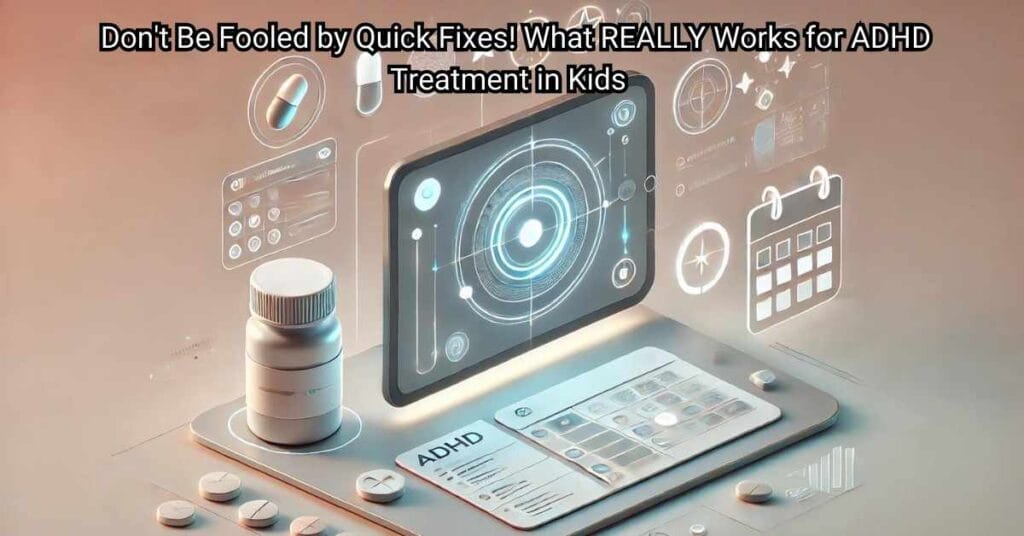A Comprehensive Guide to Complementary Treatments for ADHD: Understanding Options, Costs, and Effectiveness

Introduction
Attention Deficit Hyperactivity Disorder (ADHD) is a complex condition that manifests differently in each individual. While medication is often the initial approach to treatment, many families seek additional or alternative methods to manage symptoms and enhance their child’s quality of life. At Dr. John Flett’s practice, we embrace a holistic approach to managing ADHD, helping every child reach their fullest potential. Complementary treatments such as exercise, coaching, cognitive behavioural therapy (CBT), mindfulness, nutrition, neurofeedback, and brain training offer diverse ways to support those with ADHD. In this guide, we delve into these options, how they work, their costs in South African Rand, and their effectiveness based on current research.
1. Exercise for ADHD
What It Is:
Exercise is one of the most effective and accessible complementary treatments for ADHD. Regular physical activity, especially cardiovascular exercises, boosts dopamine and norepinephrine levels—chemicals in the brain that are crucial for attention and mood regulation.
How It Works:
Exercise helps manage ADHD symptoms by improving mood, enhancing focus, and reducing hyperactivity and impulsivity. Studies consistently show that physical activity improves executive function, which includes skills like planning, organising, and memory.
Effectiveness:
Research strongly supports the effectiveness of exercise as a complementary treatment for ADHD. For instance, a study in The Journal of Pediatrics found that children who regularly engaged in physical activity had significantly better attentiveness and task completion compared to those who were less active.
Cost and Accessibility:
Exercise is a relatively low-cost option. Activities such as running, swimming, or even structured play do not require significant financial investment. The challenge lies in maintaining consistency, as regular exercise routines can be difficult for children, especially those who struggle with motivation. Costs associated with organised sports or gym memberships might range from R200 to R1,500 per month.
Priority and Implementation:
Given its low cost and broad benefits, exercise should be among the first complementary treatments to consider. It’s a holistic approach that not only aids in ADHD management but also promotes overall physical and emotional well-being.
2. ADHD Coaching
What It Is:
ADHD coaching involves working with a trained professional to develop strategies that help manage the daily challenges associated with ADHD, such as time management, organisation, and goal setting.
How It Works:
Coaching provides personalised advice and serves as an accountability partner, helping individuals stay on track with their goals. The coach often collaborates with the family to create systems and routines that support ADHD management.
Effectiveness:
ADHD coaching is particularly beneficial for adults and older children who face executive function challenges. Research published in the Journal of Attention Disorders indicates that participants in ADHD coaching programs experience significant improvements in goal achievement, self-confidence, and life satisfaction.
Cost and Accessibility:
Coaching can be expensive, typically ranging from R1,000 to R4,000 per session. Additionally, it’s usually not covered by medical aid, making it less accessible for some families. The effectiveness of coaching often depends on the duration and frequency of sessions, with ongoing support being crucial for sustained improvement.
Priority and Implementation:
Given the cost and ongoing commitment required, ADHD coaching may not be the first option for every family. However, for those who can afford it, coaching can be incredibly valuable, especially when combined with other treatments.
3. Cognitive Behavioural Therapy (CBT)
What It Is:
CBT is a type of psychotherapy that focuses on changing negative thought patterns and behaviours. For individuals with ADHD, CBT can help manage symptoms such as impulsivity, emotional dysregulation, and low self-esteem.
How It Works:
CBT teaches coping strategies and problem-solving skills. For example, a child might learn to recognise triggers for impulsive behaviour and develop alternative responses. CBT also helps individuals understand the connection between their thoughts, emotions, and actions.
Effectiveness:
CBT is widely regarded as an effective treatment for ADHD, especially for managing comorbid conditions like anxiety and depression. A meta-analysis in Clinical Psychology Review found that CBT significantly reduces ADHD symptoms, particularly in adolescents and adults.
Cost and Accessibility:
CBT can be costly, with sessions typically ranging from R1,200 to R3,000 each. While some medical aids may cover CBT, it often requires a referral and may have limits on the number of sessions covered. Finding a therapist who specialises in ADHD can also be challenging.
Priority and Implementation:
CBT is highly recommended for individuals who struggle with the emotional and behavioural aspects of ADHD. Although it may require a financial investment, the skills learned in CBT can provide long-term benefits, making it a worthwhile consideration for families.
4. Mindfulness for ADHD
What It Is:
Mindfulness involves practices that focus on being present in the moment, such as meditation, deep breathing, and body awareness exercises. It aims to reduce stress and improve emotional regulation.
How It Works:
Mindfulness helps individuals with ADHD by training the brain to focus on the present moment, reducing the mind’s tendency to wander. This can lead to better control over emotions, improved attention span, and a decrease in impulsivity.
Effectiveness:
Research on mindfulness for ADHD is promising. A study published in The Journal of Child and Family Studies found that mindfulness-based interventions significantly improved attention and reduced hyperactivity in children with ADHD. However, the benefits are often contingent on regular practice, which can be difficult to maintain.
Cost and Accessibility:
Mindfulness can be practiced at home with little to no cost, making it highly accessible. Many online resources, apps, and guided meditation programs are available for free or at a low cost. For those seeking structured guidance, mindfulness classes or therapy sessions can range from R600 to R2,000 per session.
Priority and Implementation:
Mindfulness is a valuable complementary treatment for ADHD due to its low cost and potential benefits. It is particularly useful when combined with other treatments and can be implemented as a daily practice at home.
5. Nutrition and Supplements for ADHD
What It Is:
Dietary modifications and nutritional supplements are often used to manage ADHD symptoms. Common approaches include reducing sugar intake, eliminating artificial additives, and increasing the consumption of protein, omega-3 fatty acids, and certain vitamins and minerals.
How It Works:
Nutrition impacts brain function and overall health. For instance, omega-3 fatty acids, found in fish oil, are essential for brain health and have been shown to improve attention and reduce hyperactivity. Similarly, reducing sugar and artificial additives may help decrease behavioural problems in some children with ADHD.
Effectiveness:
The evidence supporting dietary changes and supplements is mixed. Some studies show positive effects, such as those highlighted in The American Journal of Psychiatry, which found that omega-3 supplements had a modest but significant impact on reducing hyperactivity. However, results can vary widely among individuals.
Cost and Accessibility:
The cost of dietary changes depends on the specific modifications. While eliminating junk food might save money, increasing the intake of fresh produce or supplements can be expensive, ranging from R200 to R1,000 per month.
Priority and Implementation:
Nutrition and supplements should be part of a broader treatment plan. While they may not be the first line of treatment, they can be beneficial, especially for families seeking non-pharmaceutical options. It’s important to consult with a healthcare provider before making significant dietary changes or starting supplements.
6. Neurofeedback for ADHD
What It Is:
Neurofeedback is a form of biofeedback that teaches individuals to regulate brainwave activity. It’s based on the idea that ADHD symptoms are linked to abnormal brainwave patterns, which can be modified through training.
How It Works:
During neurofeedback sessions, individuals are connected to a computer that monitors brainwave activity. Through real-time feedback, they learn to increase or decrease specific brainwave frequencies associated with attention and relaxation.
Effectiveness:
The effectiveness of neurofeedback for ADHD is debatable. Some studies, like one published in The Journal of Attention Disorders, suggest that neurofeedback can improve attention and reduce hyperactivity. However, other studies have found no significant difference between neurofeedback and placebo treatments, making it a borderline option for ADHD management.
Cost and Accessibility:
Neurofeedback is one of the more expensive complementary treatments, with costs ranging from R1,000 to R3,000 per session. A full course of treatment can require 20 to 40 sessions, making it a significant financial investment. Additionally, neurofeedback is not widely available, and finding a qualified practitioner can be challenging.
Priority and Implementation:
Given the mixed evidence and high cost, neurofeedback may not be the first option for most families. However, it can be considered for those who have not found success with other treatments and are willing to make a financial commitment. It is important to approach this treatment with caution, considering its borderline effectiveness.
7. Brain Training for ADHD
What It Is:
Brain training involves cognitive exercises designed to improve specific mental skills, such as working memory, attention, and problem-solving. These exercises are often delivered through computer programs or apps.
How It Works:
The goal of brain training is to enhance cognitive function by practicing tasks that challenge the brain. The idea is that regular practice can lead to improvements in everyday life, such as better attention and impulse control.
Effectiveness:
The evidence for brain training is mixed. While some studies, like those published in Neurotherapeutics, show that brain training can lead to improvements in working memory and attention, others suggest that these benefits may not generalise to real-world tasks. Additionally, the improvements are often modest and require consistent practice.
Cost and Accessibility:
Brain training programs vary in cost. Some apps and online platforms offer free or low-cost programs, while others may charge a subscription fee ranging from R200 to R1,000 per month. The accessibility of these programs makes them an appealing option for families, although the effectiveness may vary.
Priority and Implementation:
Brain training can be a useful supplementary tool but should not be relied upon as a primary treatment. It is best used in combination with other interventions, such as medication, therapy, or coaching, to maximise its potential benefits.
Conclusion
Managing ADHD is a multifaceted process that requires a combination of treatments tailored to the individual’s needs. While ADHD is not a nutritional problem, holistic approaches involving proper nutrition, regular exercise, mindfulness, and adequate sleep can significantly reduce the amount of medication needed. At Dr. John Flett’s practice, we are committed to embracing holistic management strategies that help every child reach their full potential.
When considering complementary treatments, it is essential to weigh the costs, potential benefits, and practicality for your family. A holistic approach that combines several strategies is often the most effective way to manage ADHD symptoms and improve overall well-being.
We encourage you to explore these options and share your experiences with us. Your feedback helps us better understand what works and supports other families on their journey.
This comprehensive guide provides detailed insights into various complementary treatments for ADHD, offering parents the information they need to make informed decisions about their child’s care.



Responses